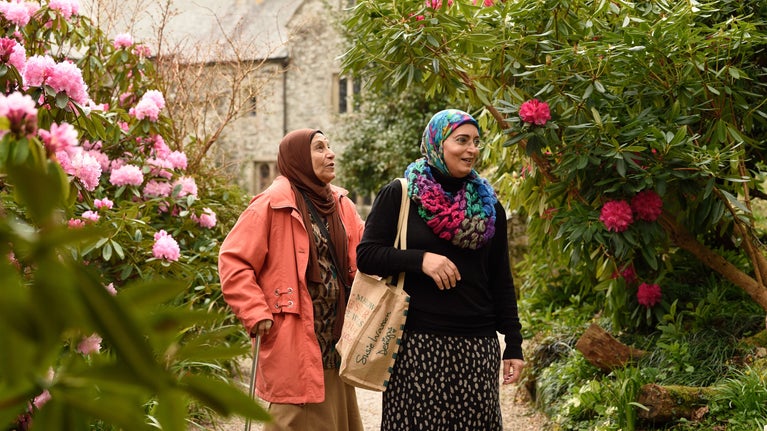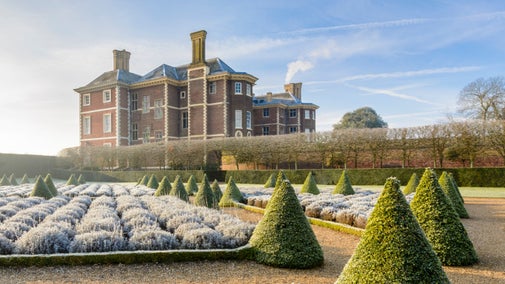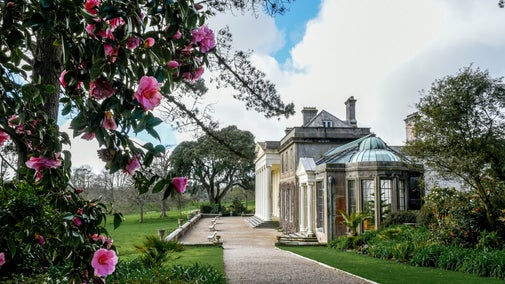
Discover more at Cotehele
Find out when Cotehele is open, how to get here, the things to see and do and more.

The Edgcumbe family preserved Cotehele house as a historic talking point rather than a comfortable family home. The rooms and artefacts inside this medieval house tell many stories about its long history. This Cornish house can claim to measure time according to a 15th-century clock, owns some of the National Trust’s rarest tapestries and even has mighty whale jawbones decorating a doorway.
To allow our teams to complete conservation work over the winter, the house may be closed completely or a limited number of rooms will be open. From 11 - 20 November, only the Hall of the House will be open whilst the garland is constructed. From 22 November - 5 January, the Hall, Kitchen, Breakfast Room and Victorian Library will be open, with all other rooms closed. The entire house will be closed from 3 - 10 November, 21 November and from 6 January - 6 March.
Originally built in the medieval times, Cotehele’s fortified manor house is set on a high bluff on the Cornish bank of the river Tamar. This chosen spot gave natural protection from skirmishing armies that might approach from the east.
The house is an architectural hotchpotch, predominantly re-built in Tudor times. First consecrated in 1411, the chapel was then re-modelled in the early 1500s. Around the same time, the Great Hall was widened and the south wall was moved forward. This ‘squashed’ the chapel into a corner.

Inside the rambling walls, Cotehele houses an impressive collection of tapestries, armour and fine oak furniture. Its fascinating collection reflects the Edgcumbe’s fondness for antiques during the Georgian era.
The family developed Cotehele’s interiors between about 1750 and 1860. They were deliberately attempting to evoke a sense of nostalgia and recreate the atmosphere of the ‘good old days’.
Flanking the doorway in the Great Hall, and at more than 2.5 metres high, are a whale’s jawbones. While whalebone was commonly used to produce a variety of objects throughout history, it’s unusual to find intact jawbones. In fact, this is the only example in the National Trust’s collections.
The jawbones’ origins were a mystery until recent research and DNA testing revealed that they belonged to a common rorqual whale. At 18-metres long, the marine giant washed up at nearby Colona Beach, Mevagissey in 1875.

Found inside the medieval chapel is the turret clock. This set of wrought iron mechanisms began ticking more than 500 years ago around the start of the Tudor era.
With no face, dial or even hands, it simply strikes the hour on a bell in the chapel roof. While the clock can run for 24 hours, winding it requires considerable strength and agility. Until it was restored in the mid 20th century, it’d likely stood unwound and silent for centuries.
Find out more about the turret clock here.
Among the stranger objects inside Cotehele’s house is a mechanical arm from the late 16th or early 17th centuries. Terrible injuries on bloody battlefields during the Tudor and Stuart eras led surgeons of the day to design prostheses for lost limbs.
Some prostheses, like the elaborate one that calls Cotehele home, were made with moveable fingers in a mechanical vambrace. They can lock into place, which allowed an amputee soldier to grip his reins or sword.
A modern replica of this mechanical arm was created, thanks to a generous donation. This means that visitors can usually get up close and touch the prosthesis to see how it works.
Find out more about the mechanical arm here.
Cotehele is known for its impressive collection of tapestries. It includes one of three surviving fragments, dating from the late 15th or early 16th centuries. These are some of the earliest English tapestries in the Trust’s collections.
The fragments inside Cotehele’s house feature fearsome wild boar heads with sharp pointed tusks and a wreath of leaves. These were designed as part of family heraldry and can be associated with Sir Piers Edgcumbe, who inherited the Cotehele estate in 1489.

Find out when Cotehele is open, how to get here, the things to see and do and more.
Take a stroll around the 5.5 hectares of Cotehele's garden where you’ll discover terraced herbaceous borders, a lily pond as well as a medieval stewpond and dovecote.

There's lots to discover at the Cotehele estate. Miles of pathways lead you through ancient woodland, past a historic chapel, and to an important Victorian quay.

Tuck into a cream tea at one of Cotehele’s cafés, find an eco-friendly gift or plant at the shop, and discover local artists at The Bull Pen Gallery.

Uncover centuries of Cotehele’s history, from a medieval home, developed after the Battle of Bosworth to a family estate given to the National Trust after the Second World War.

Dogs are welcome to join you at Cotehele. There are miles of paths and loads of space where they can stretch their legs and bowls of clean water once they’re thirsty. Cotehele is a two pawprint rated place.

Historic houses and buildings are full of stories, art and collections. Learn more about their past and plan your next visit.

Discover a vast range of houses and buildings to visit in Cornwall. From a Victorian mansion and Tudor homes to heritage mining buildings and lesser-known gems.
